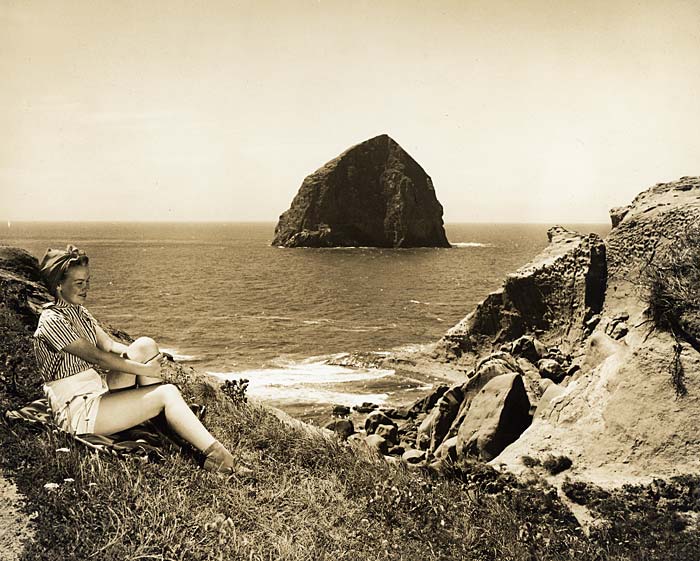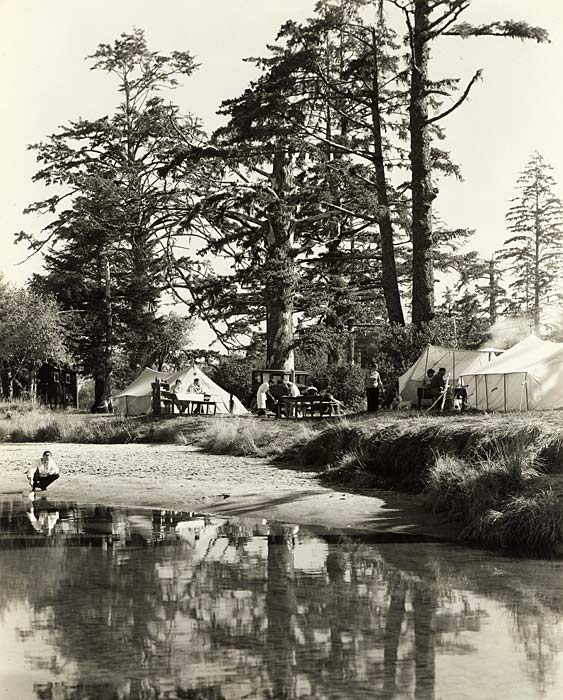TILLAMOOK, 76.9 m. (23 alt., 2,549 pop.), seat of Tillamook County, is the prosperous trade center of the dairy region. Early in the morning the dairy ranchers (never called farmers) arrive at the factory weighing-in platforms, where an attendant checks the quantity of milk delivered and takes samples for the butter-fat test that determines the rate of payment. After the ranchers have delivered their milk they drive to the whey tank to load empty milk cans with the liquid that is left after removal of the milk curd. This whey is valuable as hog feed.
 Haystack Rock and a Chevrolet-the location is uncertain (1238). Enlarge image.
Haystack Rock and a Chevrolet-the location is uncertain (1238). Enlarge image.
By eight in the morning, after all the milk has been received, the cheese makers empty the fresh milk into huge stainless steel vats and add rennet, salt, and coloring matter to it before turning steam into the jackets around the vats. As soon as coagulation starts, long rakes of wire begin a steady movement through the curd to cut and break it. When the curd has been completely separated from the liquid, it is pressed into molds of various shapes that have been lined with cloth. Finally, the containers of the new cheeses are stamped with the trade name and coated with paraffin. The round disks are placed in rows in curing rooms where cool air of constant temperature is circulated.
Butter making is being carried on in connection with cheese making in various places, the cheese being made from the skim milk. Most cheese masters are quite willing to permit visitors to sample the pleasant-tasting fresh curd. Even visitors who do not care for its taste usually like to eat a small amount because of the peculiar squeaks produced when it is chewed. Here are cooperative cheese factories that are well worth a visit. Here also are lumber mills and box factories.
 Haystack Rock from Cape Kiwanda-the location is uncertain (1508). Enlarge image.
Haystack Rock from Cape Kiwanda-the location is uncertain (1508). Enlarge image.
Loggers, fishermen, and dairymen are seen on Tillamook streets, particularly on Saturday. The notice "No caulked boots allowed" is seen where woodsmen congregate. These caulks, sharp spikes attached to soles of shoes, are a necessity in the woods where life depends on swift, sure balance.
Some establishments provide shingles or pieces of tire casing for the convenience of their customers; the logger steps on these (which adhere to his shoes) and walks or slides along without damaging the floors. Loggers, not permitted to smoke while at work, are identified by their chewing tobacco and "snoose" (snuff) and by their boots and "tin pants" (water-proofed canvas trousers cut short or "stagged"). Knee boots are commonly worn by dairymen who wade through marshes to herd cows. Hip boots and sou'westers, and sometimes beach slickers, identify the fishermen.
Tillamook is the western terminus of the Wilson River Highway.
Right from Tillamook to NETARTS (boats for deep-sea fishing), 7.6 m. (46 pop.), a beach resort by Netarts Bay, where waters have been planted with Japanese oysters. Several varieties of clams are dug here.
 Neskowin auto camp scene (138). Enlarge image.
Neskowin auto camp scene (138). Enlarge image.
The road continues to OCEANSIDE, 10.1 m. (24 pop.), another resort. Offshore are THREE ARCH ROCKS, massive wave-worn monoliths that have been made a bird refuge. The rocks are crowded with bird and sea life. At their base during low tide are sea lions. This is the locale of an essay in Dallas Lore Sharp's book, "Where Rolls the Oregon."
At SOUTH PRAIRIE, 80.9 m., is a large CHEESE FACTORY (visitors 8-12), one of the many in the lower valleys of the Trask and Tillamook rivers.
At 94.5 m. the route crosses a narrow strip connecting two sections of the SIUSLAW NATIONAL FOREST. The route traverses this forest at intervals for 150 miles.
The NESTUCCA RIVER (steelhead trout, late fall and early winter), 96.5 m. Commercial fishing in this stream is prohibited.
HEBO, 97.3 m. (54 alt., 275 pop.), at the junction with State 14, was named for Mount Hebo (L.).
South of Hebo for a distance of 30 miles the highway skirts a unit of a large area of burned-over land developed as a forest conservation and recreational project by the Farm Security Administration. Holland grass has been planted to halt the advance of sand dunes on the forests.
 Storm at Boiler Bay Park (1617). Enlarge image.
Storm at Boiler Bay Park (1617). Enlarge image.
South of CLOVERDALE, 99.9 m. (26 alt., 189 pop.), a dairymen's trading center, the highway follows a dike separating tideland pastures along the Little Nestucca River. The small sharpened shovels used to dig blue clams along the river are called "clam guns."
NESKOWIN (Ind., plenty of fish), 110.2 m. (17 alt., 65 pop.), has a wide view of the ocean and an excellent beach. Numerous varieties of fish, including cutthroat and steelhead trout, Chinook and silverside salmon, bass, halibut, flounder, and perch inhabit the waters.
Between the Neskowin drainage basin and the Salmon River, evergreens grow so thickly along the highway that there is scarcely any undergrowth except huckleberry. When this section of highway was constructed, the hemlocks and firs were cut in short lengths and corded along the right-of-way. Since there was no way to burn them without endangering forest and no demand for the wood, the huge piles have remained along the roadside.
OTIS, 121 m. (37 alt., 23 pop.), was the western terminus of the Salmon River Toll Road. At OTIS JUNCTION, 121.4 m., U.S. 101 meets State 18.
 Boiler Bay (2457). Enlarge image.
Boiler Bay (2457). Enlarge image.
NEOTSU (golf course and club house; summer regatta), 124.6 m., is at the northern end of DEVILS LAKE. According to Indian legend, in these waters lived a giant fish or monster that occasionally rose to the surface to attack people.
OCEAN LAKE, 126.6 m. (115 alt., 400 pop.), is a coast town supported by sportsmen and vacationists. DELAKE (hotel and camps), 127.5 m. (62 alt.), at the southern end of Devils Lake, probably received its name from the pronunciation given Devils Lake by many local Finnish people.
On the beach at NELSCOTT, 129.2 m. (35 alt., 150 pop.), as elsewhere along the Oregon coast, Japanese floats (colored glass balls) are frequently found. These floats, used as net supports by fishermen, are carried across the ocean by the Japanese current. They are prized by vacationists for decorative purposes. A line of substantial cottages faces the ocean here.
TAFT, 130.4 m. (11 alt., 23 pop.), is the scene of the annual Red Head Round-Up (first week in August), which brings together the region's titian-crowned beauties to compete for prizes. This small town with a hotel and cottages, has a greatly augmented population in summer. Taft is at the southern end of the conservation unit. U.S. 101 rounds Siletz Bay.